Analysis of Enterprise Architecture in Health Information Technology
VerifiedAdded on 2023/06/13
|20
|3512
|186
Report
AI Summary
This report provides an analysis of electronic health record (EHR) development through Enterprise Information Architecture Reference Architecture. It details the use of this architecture, highlighting its templates and their role in depicting the project's phases. The report illustrates conceptual architecture, logical architecture, component relationships, and component interactions, emphasizing the management and integration aspects. It also discusses the operational model and potential challenges in implementing and learning the system, including budget constraints, expertise requirements, and privacy concerns. The report concludes by offering possible strategies to mitigate these challenges and recommendations for successful EHR development. This document is shared on Desklib, a platform that provides students with access to a wealth of study resources, including solved assignments and past papers.
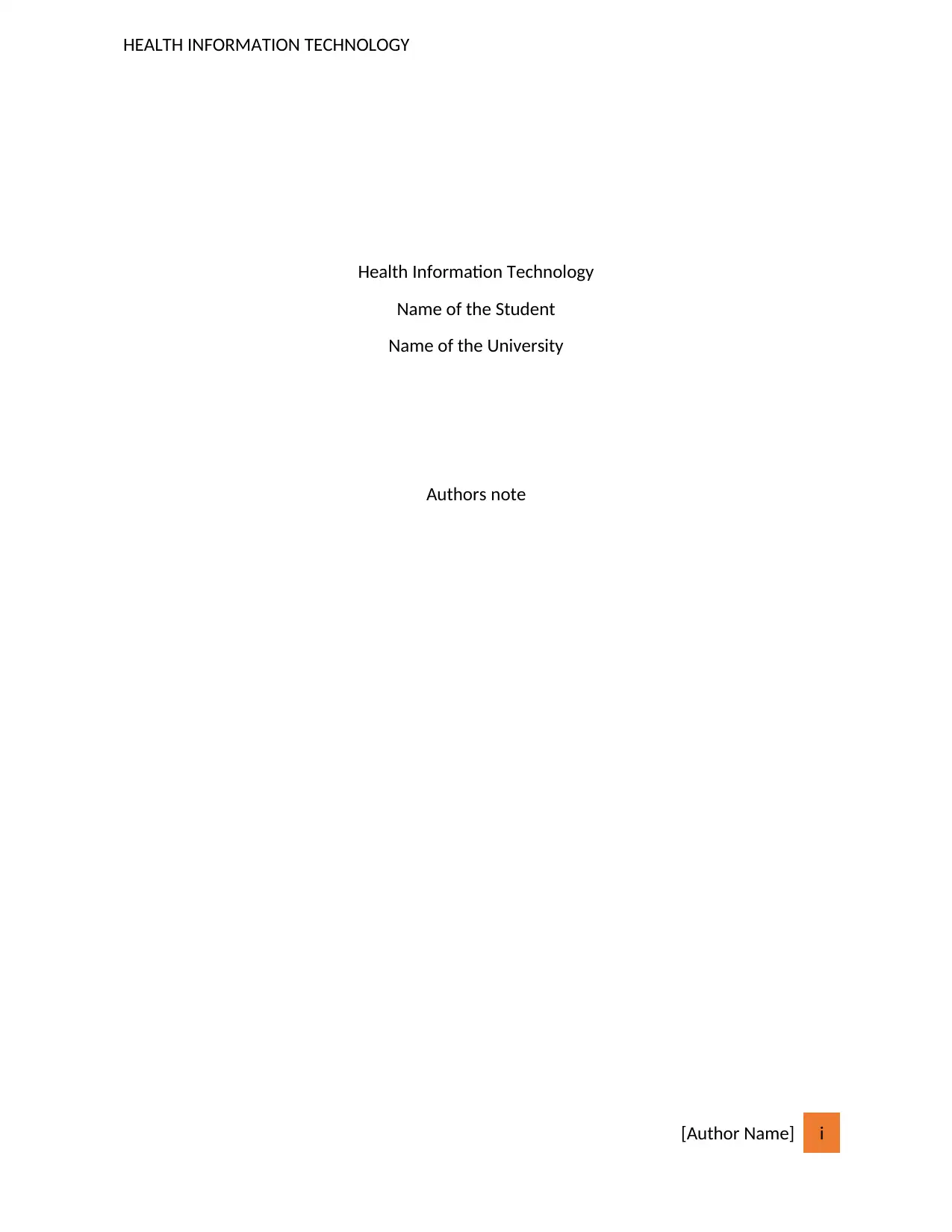
HEALTH INFORMATION TECHNOLOGY
Health Information Technology
Name of the Student
Name of the University
Authors note
[Author Name] i
Health Information Technology
Name of the Student
Name of the University
Authors note
[Author Name] i
Paraphrase This Document
Need a fresh take? Get an instant paraphrase of this document with our AI Paraphraser
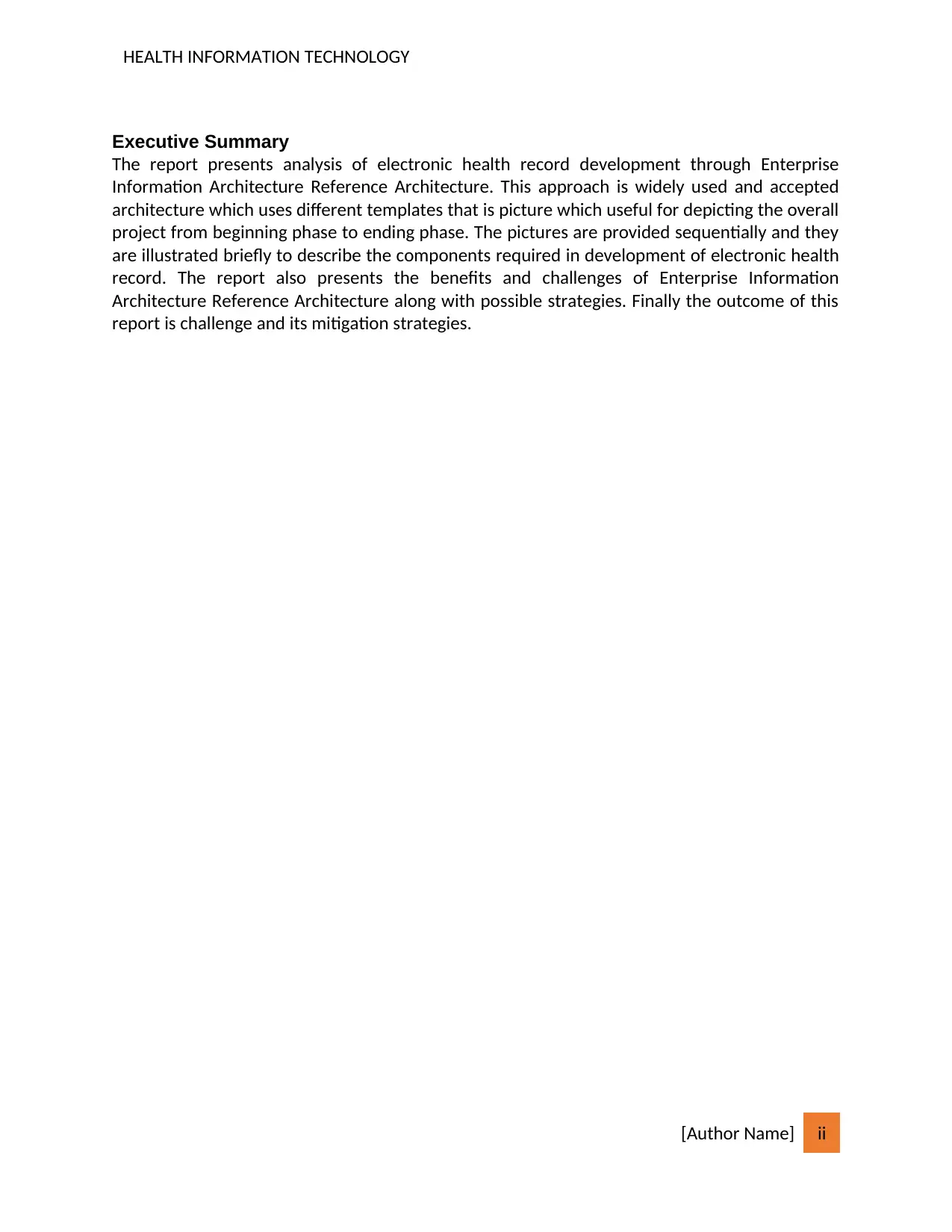
HEALTH INFORMATION TECHNOLOGY
Executive Summary
The report presents analysis of electronic health record development through Enterprise
Information Architecture Reference Architecture. This approach is widely used and accepted
architecture which uses different templates that is picture which useful for depicting the overall
project from beginning phase to ending phase. The pictures are provided sequentially and they
are illustrated briefly to describe the components required in development of electronic health
record. The report also presents the benefits and challenges of Enterprise Information
Architecture Reference Architecture along with possible strategies. Finally the outcome of this
report is challenge and its mitigation strategies.
[Author Name] ii
Executive Summary
The report presents analysis of electronic health record development through Enterprise
Information Architecture Reference Architecture. This approach is widely used and accepted
architecture which uses different templates that is picture which useful for depicting the overall
project from beginning phase to ending phase. The pictures are provided sequentially and they
are illustrated briefly to describe the components required in development of electronic health
record. The report also presents the benefits and challenges of Enterprise Information
Architecture Reference Architecture along with possible strategies. Finally the outcome of this
report is challenge and its mitigation strategies.
[Author Name] ii
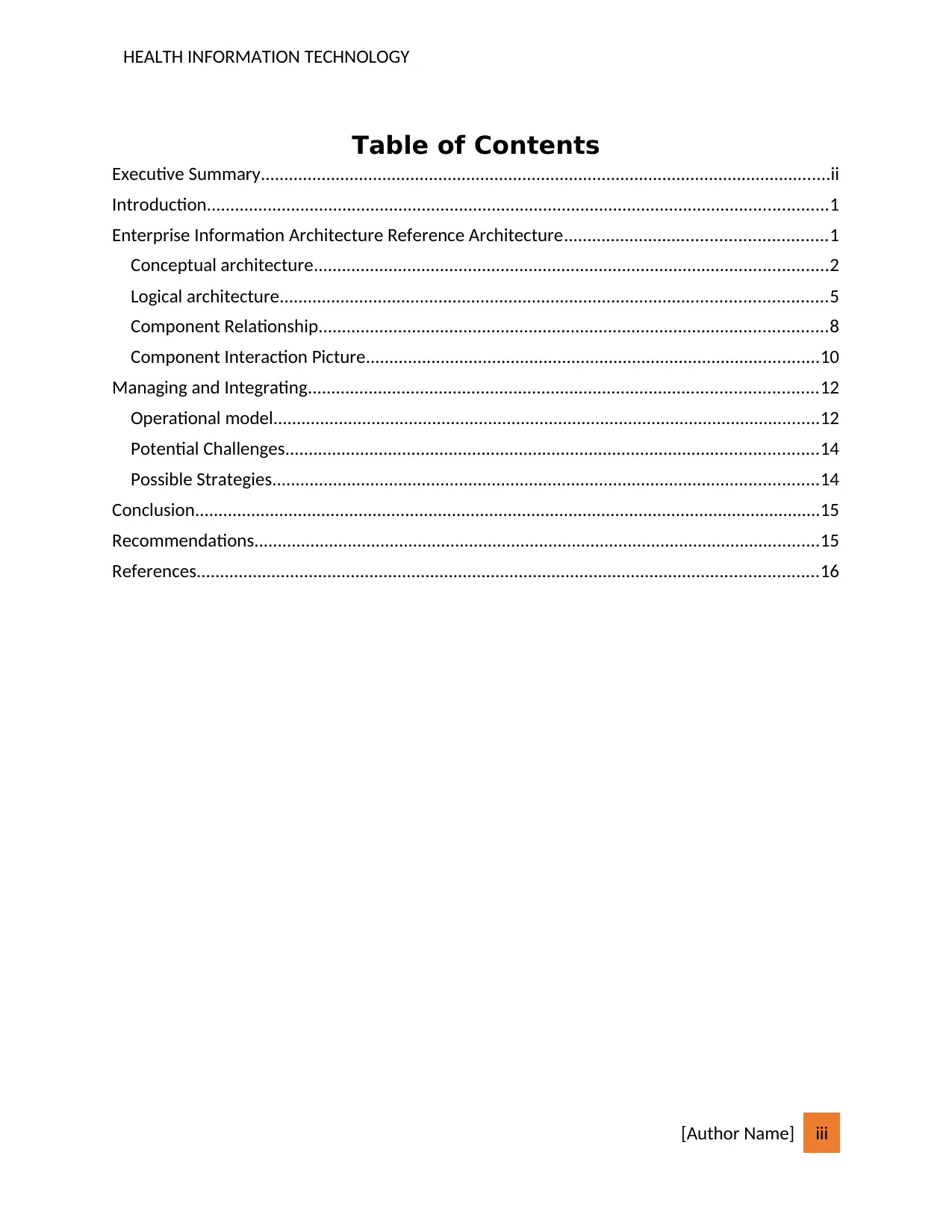
HEALTH INFORMATION TECHNOLOGY
Table of Contents
Executive Summary..........................................................................................................................ii
Introduction.....................................................................................................................................1
Enterprise Information Architecture Reference Architecture........................................................1
Conceptual architecture..............................................................................................................2
Logical architecture.....................................................................................................................5
Component Relationship.............................................................................................................8
Component Interaction Picture.................................................................................................10
Managing and Integrating.............................................................................................................12
Operational model.....................................................................................................................12
Potential Challenges..................................................................................................................14
Possible Strategies.....................................................................................................................14
Conclusion......................................................................................................................................15
Recommendations.........................................................................................................................15
References.....................................................................................................................................16
[Author Name] iii
Table of Contents
Executive Summary..........................................................................................................................ii
Introduction.....................................................................................................................................1
Enterprise Information Architecture Reference Architecture........................................................1
Conceptual architecture..............................................................................................................2
Logical architecture.....................................................................................................................5
Component Relationship.............................................................................................................8
Component Interaction Picture.................................................................................................10
Managing and Integrating.............................................................................................................12
Operational model.....................................................................................................................12
Potential Challenges..................................................................................................................14
Possible Strategies.....................................................................................................................14
Conclusion......................................................................................................................................15
Recommendations.........................................................................................................................15
References.....................................................................................................................................16
[Author Name] iii
⊘ This is a preview!⊘
Do you want full access?
Subscribe today to unlock all pages.

Trusted by 1+ million students worldwide

HEALTH INFORMATION TECHNOLOGY
Introduction
United States Government has legislated electronic health record which will provide
advantages to customers and medical health providers. The management and maintenance will
facilitate data integration and data sharing among medical health providers. A design is
required by Australian Government to accomplish electronic health record development. The
report presents description on benefits of an architecture called Enterprise Information
Architecture Reference Architecture that will help in developing electronic health record ( Da Xu
2014). This is achieved through processes that are in analytic way, assumed to be tried and true
methods. Enterprise Information Architecture Reference Architecture approach helps to
provide a design to develop building blocks from basic to more detailed building blocks for any
system. This architecture helps an organization to manage a project from beginning to end
where the project is created, maintained, used and governed through their life cycle from
perspective of bottom-up. Enterprise Information Architecture Reference Architecture is an
architecture that helps to provide view in an information-centric way of the Enterprise
Architecture (Giachetti 2016). The purpose of this report is to present an analysis of benefits
and challenges of Enterprise Information Architecture Reference Architecture to develop
electronic health record.
The outline is use of template of Enterprise Information Architecture Reference
Architecture for electronic health record. The templates are conceptual architecture, logical
architecture, component relationship picture, component interaction picture, operational
picture. The first part involves benefits of Enterprise Information Architecture Reference
Architecture and second part involves challenges of data managing and integrating.
Enterprise Information Architecture Reference Architecture
The advantages provided by Enterprise Information Architecture Reference Architecture
for developing electronic health record are as follows.
Correspondence of enterprise- The storing of information in various locations in form of
distributed database and conflicting. This approach helps two information s to use and
understand each other’s characteristics and functionality. The interoperability approach
of enterprise helps to provides services between different information, exchange and
communicate (Romero and Vernadat 2016). The benefits provided by Enterprise
Information Architecture Reference Architecture are at three different levels that are
data, services and processes.
Incorporation of enterprise- The objective of electronic health record is achieved by the
help of Enterprise Information Architecture Reference Architecture approach where
communication between components of enterprises is ensured. The approach of
integration of enterprise is accomplished at different levels in different ways. This
approach includes integration of physical, business and application layer. The first layer
that is physical integration consists of interconnection of devices and machines that are
connected (Cabrera et al. 2016). The second layer that is business integration consists of
management, monitoring and to control business functions and processes. The added
layer of integration is enterprise modelling that helps to accomplish persistent decision
making.
[Author Name] 1
Introduction
United States Government has legislated electronic health record which will provide
advantages to customers and medical health providers. The management and maintenance will
facilitate data integration and data sharing among medical health providers. A design is
required by Australian Government to accomplish electronic health record development. The
report presents description on benefits of an architecture called Enterprise Information
Architecture Reference Architecture that will help in developing electronic health record ( Da Xu
2014). This is achieved through processes that are in analytic way, assumed to be tried and true
methods. Enterprise Information Architecture Reference Architecture approach helps to
provide a design to develop building blocks from basic to more detailed building blocks for any
system. This architecture helps an organization to manage a project from beginning to end
where the project is created, maintained, used and governed through their life cycle from
perspective of bottom-up. Enterprise Information Architecture Reference Architecture is an
architecture that helps to provide view in an information-centric way of the Enterprise
Architecture (Giachetti 2016). The purpose of this report is to present an analysis of benefits
and challenges of Enterprise Information Architecture Reference Architecture to develop
electronic health record.
The outline is use of template of Enterprise Information Architecture Reference
Architecture for electronic health record. The templates are conceptual architecture, logical
architecture, component relationship picture, component interaction picture, operational
picture. The first part involves benefits of Enterprise Information Architecture Reference
Architecture and second part involves challenges of data managing and integrating.
Enterprise Information Architecture Reference Architecture
The advantages provided by Enterprise Information Architecture Reference Architecture
for developing electronic health record are as follows.
Correspondence of enterprise- The storing of information in various locations in form of
distributed database and conflicting. This approach helps two information s to use and
understand each other’s characteristics and functionality. The interoperability approach
of enterprise helps to provides services between different information, exchange and
communicate (Romero and Vernadat 2016). The benefits provided by Enterprise
Information Architecture Reference Architecture are at three different levels that are
data, services and processes.
Incorporation of enterprise- The objective of electronic health record is achieved by the
help of Enterprise Information Architecture Reference Architecture approach where
communication between components of enterprises is ensured. The approach of
integration of enterprise is accomplished at different levels in different ways. This
approach includes integration of physical, business and application layer. The first layer
that is physical integration consists of interconnection of devices and machines that are
connected (Cabrera et al. 2016). The second layer that is business integration consists of
management, monitoring and to control business functions and processes. The added
layer of integration is enterprise modelling that helps to accomplish persistent decision
making.
[Author Name] 1
Paraphrase This Document
Need a fresh take? Get an instant paraphrase of this document with our AI Paraphraser
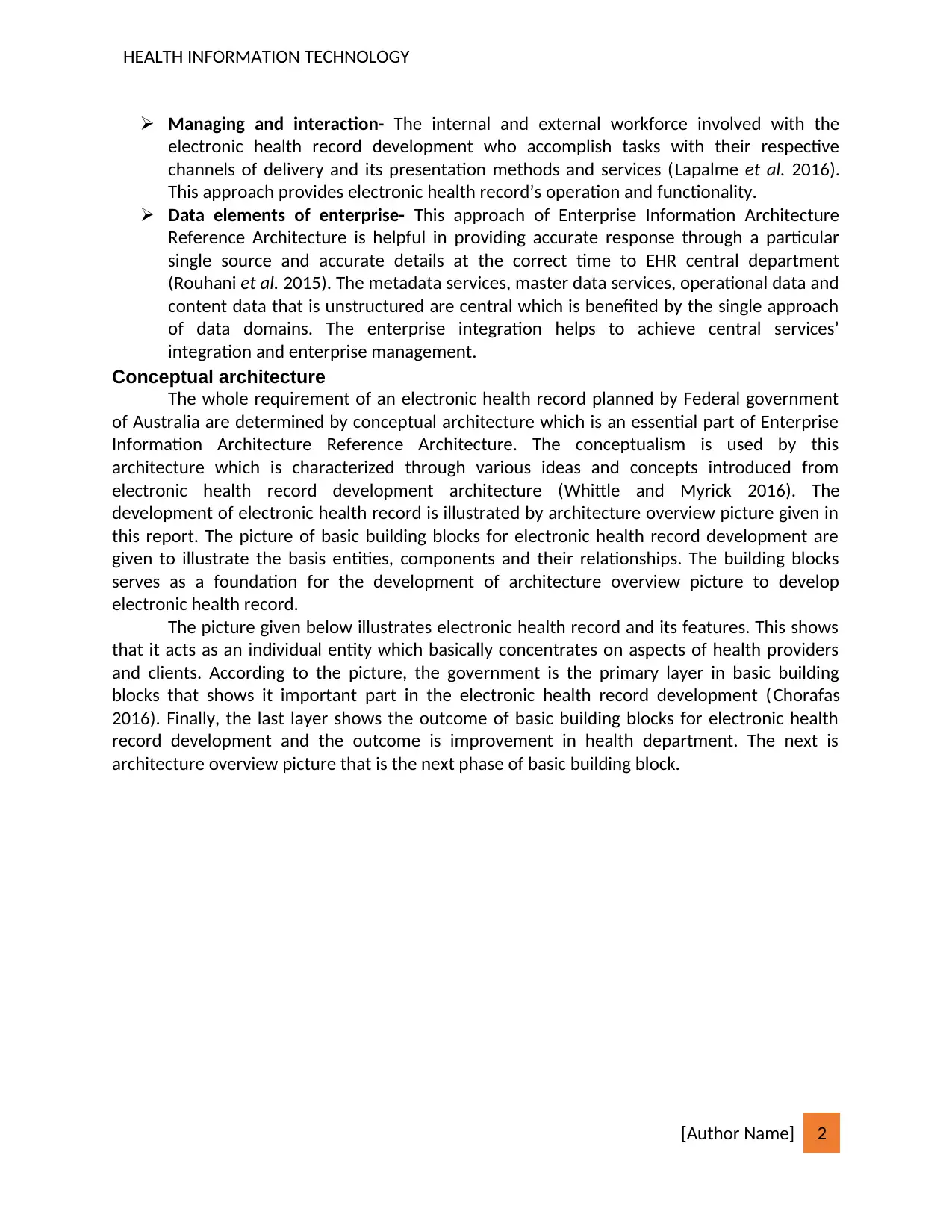
HEALTH INFORMATION TECHNOLOGY
Managing and interaction- The internal and external workforce involved with the
electronic health record development who accomplish tasks with their respective
channels of delivery and its presentation methods and services (Lapalme et al. 2016).
This approach provides electronic health record’s operation and functionality.
Data elements of enterprise- This approach of Enterprise Information Architecture
Reference Architecture is helpful in providing accurate response through a particular
single source and accurate details at the correct time to EHR central department
(Rouhani et al. 2015). The metadata services, master data services, operational data and
content data that is unstructured are central which is benefited by the single approach
of data domains. The enterprise integration helps to achieve central services’
integration and enterprise management.
Conceptual architecture
The whole requirement of an electronic health record planned by Federal government
of Australia are determined by conceptual architecture which is an essential part of Enterprise
Information Architecture Reference Architecture. The conceptualism is used by this
architecture which is characterized through various ideas and concepts introduced from
electronic health record development architecture (Whittle and Myrick 2016). The
development of electronic health record is illustrated by architecture overview picture given in
this report. The picture of basic building blocks for electronic health record development are
given to illustrate the basis entities, components and their relationships. The building blocks
serves as a foundation for the development of architecture overview picture to develop
electronic health record.
The picture given below illustrates electronic health record and its features. This shows
that it acts as an individual entity which basically concentrates on aspects of health providers
and clients. According to the picture, the government is the primary layer in basic building
blocks that shows it important part in the electronic health record development (Chorafas
2016). Finally, the last layer shows the outcome of basic building blocks for electronic health
record development and the outcome is improvement in health department. The next is
architecture overview picture that is the next phase of basic building block.
[Author Name] 2
Managing and interaction- The internal and external workforce involved with the
electronic health record development who accomplish tasks with their respective
channels of delivery and its presentation methods and services (Lapalme et al. 2016).
This approach provides electronic health record’s operation and functionality.
Data elements of enterprise- This approach of Enterprise Information Architecture
Reference Architecture is helpful in providing accurate response through a particular
single source and accurate details at the correct time to EHR central department
(Rouhani et al. 2015). The metadata services, master data services, operational data and
content data that is unstructured are central which is benefited by the single approach
of data domains. The enterprise integration helps to achieve central services’
integration and enterprise management.
Conceptual architecture
The whole requirement of an electronic health record planned by Federal government
of Australia are determined by conceptual architecture which is an essential part of Enterprise
Information Architecture Reference Architecture. The conceptualism is used by this
architecture which is characterized through various ideas and concepts introduced from
electronic health record development architecture (Whittle and Myrick 2016). The
development of electronic health record is illustrated by architecture overview picture given in
this report. The picture of basic building blocks for electronic health record development are
given to illustrate the basis entities, components and their relationships. The building blocks
serves as a foundation for the development of architecture overview picture to develop
electronic health record.
The picture given below illustrates electronic health record and its features. This shows
that it acts as an individual entity which basically concentrates on aspects of health providers
and clients. According to the picture, the government is the primary layer in basic building
blocks that shows it important part in the electronic health record development (Chorafas
2016). Finally, the last layer shows the outcome of basic building blocks for electronic health
record development and the outcome is improvement in health department. The next is
architecture overview picture that is the next phase of basic building block.
[Author Name] 2
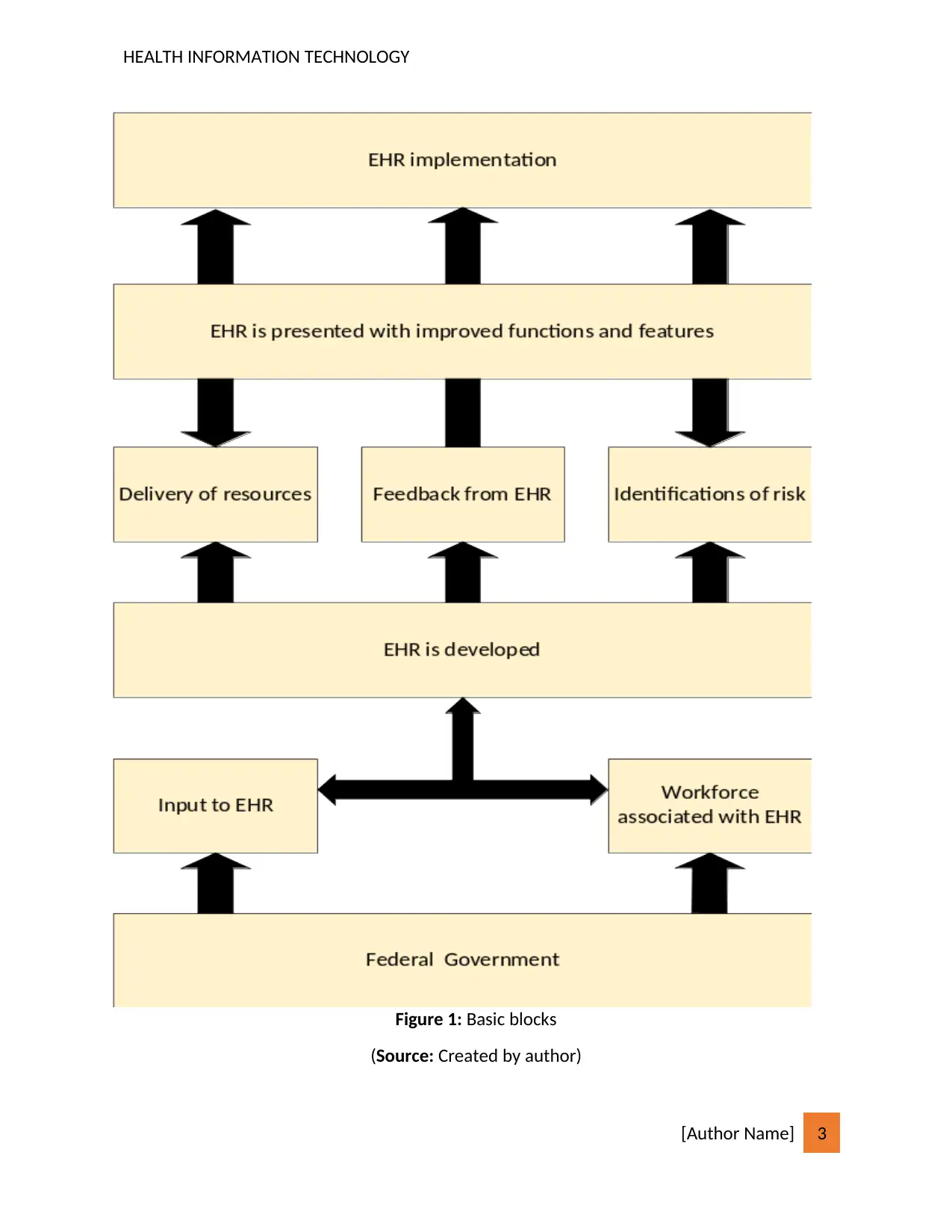
HEALTH INFORMATION TECHNOLOGY
Figure 1: Basic blocks
(Source: Created by author)
[Author Name] 3
Figure 1: Basic blocks
(Source: Created by author)
[Author Name] 3
⊘ This is a preview!⊘
Do you want full access?
Subscribe today to unlock all pages.

Trusted by 1+ million students worldwide
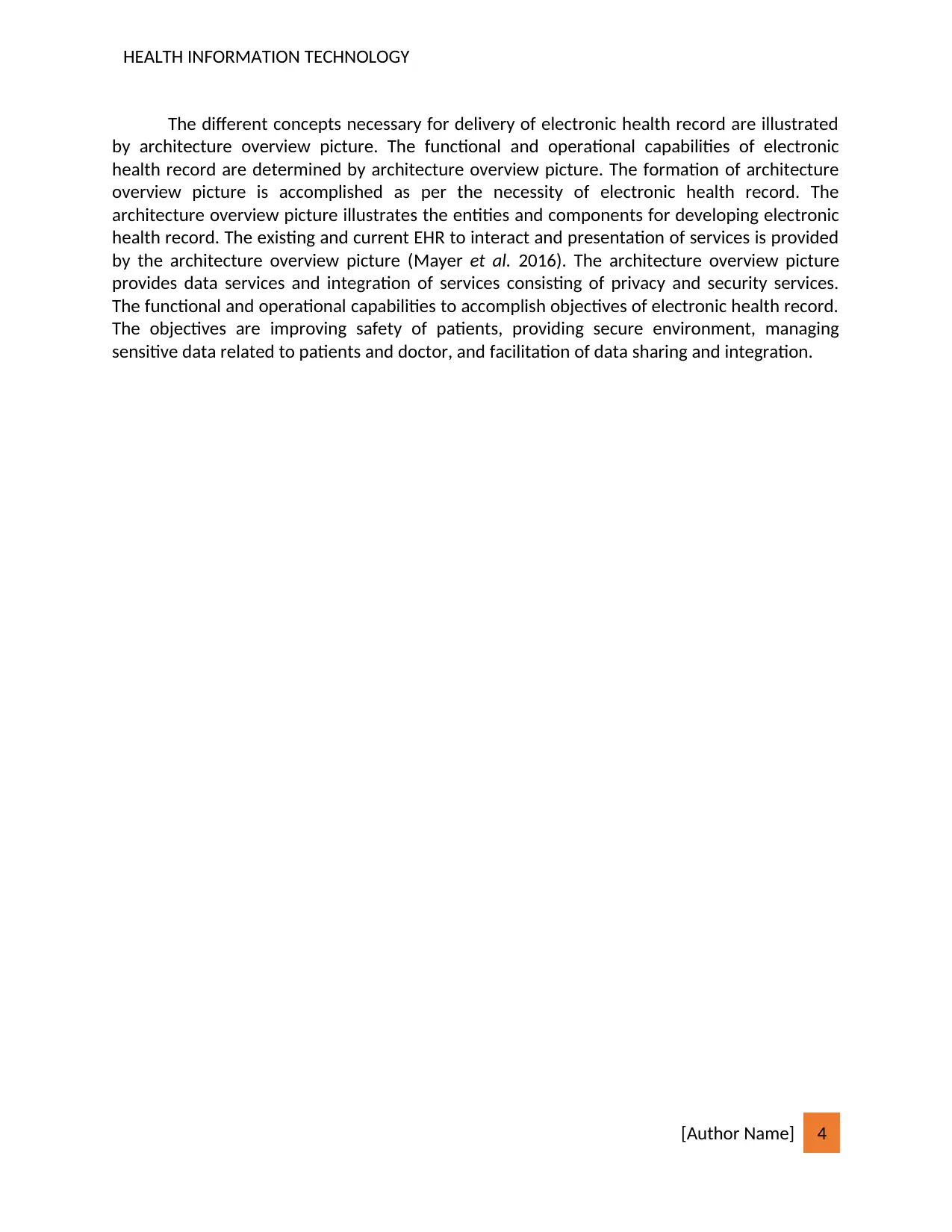
HEALTH INFORMATION TECHNOLOGY
The different concepts necessary for delivery of electronic health record are illustrated
by architecture overview picture. The functional and operational capabilities of electronic
health record are determined by architecture overview picture. The formation of architecture
overview picture is accomplished as per the necessity of electronic health record. The
architecture overview picture illustrates the entities and components for developing electronic
health record. The existing and current EHR to interact and presentation of services is provided
by the architecture overview picture (Mayer et al. 2016). The architecture overview picture
provides data services and integration of services consisting of privacy and security services.
The functional and operational capabilities to accomplish objectives of electronic health record.
The objectives are improving safety of patients, providing secure environment, managing
sensitive data related to patients and doctor, and facilitation of data sharing and integration.
[Author Name] 4
The different concepts necessary for delivery of electronic health record are illustrated
by architecture overview picture. The functional and operational capabilities of electronic
health record are determined by architecture overview picture. The formation of architecture
overview picture is accomplished as per the necessity of electronic health record. The
architecture overview picture illustrates the entities and components for developing electronic
health record. The existing and current EHR to interact and presentation of services is provided
by the architecture overview picture (Mayer et al. 2016). The architecture overview picture
provides data services and integration of services consisting of privacy and security services.
The functional and operational capabilities to accomplish objectives of electronic health record.
The objectives are improving safety of patients, providing secure environment, managing
sensitive data related to patients and doctor, and facilitation of data sharing and integration.
[Author Name] 4
Paraphrase This Document
Need a fresh take? Get an instant paraphrase of this document with our AI Paraphraser
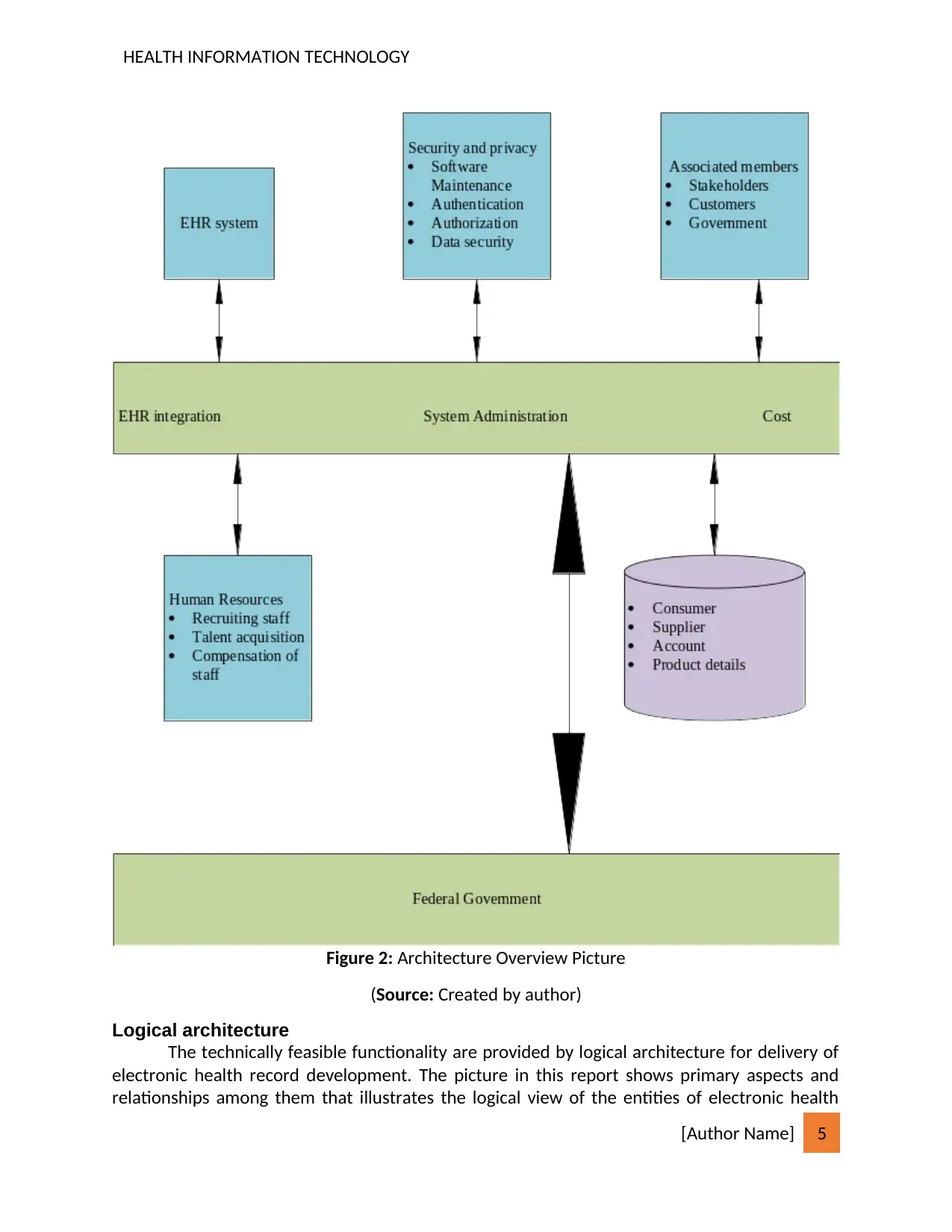
HEALTH INFORMATION TECHNOLOGY
Figure 2: Architecture Overview Picture
(Source: Created by author)
Logical architecture
The technically feasible functionality are provided by logical architecture for delivery of
electronic health record development. The picture in this report shows primary aspects and
relationships among them that illustrates the logical view of the entities of electronic health
[Author Name] 5
Figure 2: Architecture Overview Picture
(Source: Created by author)
Logical architecture
The technically feasible functionality are provided by logical architecture for delivery of
electronic health record development. The picture in this report shows primary aspects and
relationships among them that illustrates the logical view of the entities of electronic health
[Author Name] 5

HEALTH INFORMATION TECHNOLOGY
record development. The groups are engineers and framework modelers that are intended
groups related with the logical view picture for developing components of electronic health
record system.
The effectiveness of requirements of enterprise are illustrate by logical view picture
given in this report. The requirements of end users/entities are illustrated in the picture to
show the features and functions necessary for developing electronic health record (Dang and
Pekkola 2017). The data warehouse is used for broadcasting and giving the required data as
input for the whole operation of the system. The picture shows incorporation of planning,
budget, requirements, designing and related data which are determined by users in data
warehouse for electronic health record development. The primary objective of logical view is to
accomplish the required objective for patients and healthcare providers in development of
electronic health record system.
[Author Name] 6
record development. The groups are engineers and framework modelers that are intended
groups related with the logical view picture for developing components of electronic health
record system.
The effectiveness of requirements of enterprise are illustrate by logical view picture
given in this report. The requirements of end users/entities are illustrated in the picture to
show the features and functions necessary for developing electronic health record (Dang and
Pekkola 2017). The data warehouse is used for broadcasting and giving the required data as
input for the whole operation of the system. The picture shows incorporation of planning,
budget, requirements, designing and related data which are determined by users in data
warehouse for electronic health record development. The primary objective of logical view is to
accomplish the required objective for patients and healthcare providers in development of
electronic health record system.
[Author Name] 6
⊘ This is a preview!⊘
Do you want full access?
Subscribe today to unlock all pages.

Trusted by 1+ million students worldwide

HEALTH INFORMATION TECHNOLOGY
Figure 3: Logical View
(Source: Created by author)
[Author Name] 7
Figure 3: Logical View
(Source: Created by author)
[Author Name] 7
Paraphrase This Document
Need a fresh take? Get an instant paraphrase of this document with our AI Paraphraser

HEALTH INFORMATION TECHNOLOGY
Component Relationship
The relationships between various component, interfaces and entities are illustrated by
component relationship picture which helps in electronic health record development. The
various components as shown in the component relationship picture are easily inspected by the
developer in evaluating and understanding the necessary functionality and working method.
The component relationship picture is the result of logical view and architectural overview
combining together (Zarvić and Wieringa 2014). Thus this picture shows relationships of various
components and interfaces in the system. These picture delivers logical functions through the
connection of components. In component relationship picture only the components,
Information Co-Production Hub and Collaboration Hub differ from Enterprise Information
Architecture Reference Architecture that are described in component relationship picture.
[Author Name] 8
Component Relationship
The relationships between various component, interfaces and entities are illustrated by
component relationship picture which helps in electronic health record development. The
various components as shown in the component relationship picture are easily inspected by the
developer in evaluating and understanding the necessary functionality and working method.
The component relationship picture is the result of logical view and architectural overview
combining together (Zarvić and Wieringa 2014). Thus this picture shows relationships of various
components and interfaces in the system. These picture delivers logical functions through the
connection of components. In component relationship picture only the components,
Information Co-Production Hub and Collaboration Hub differ from Enterprise Information
Architecture Reference Architecture that are described in component relationship picture.
[Author Name] 8
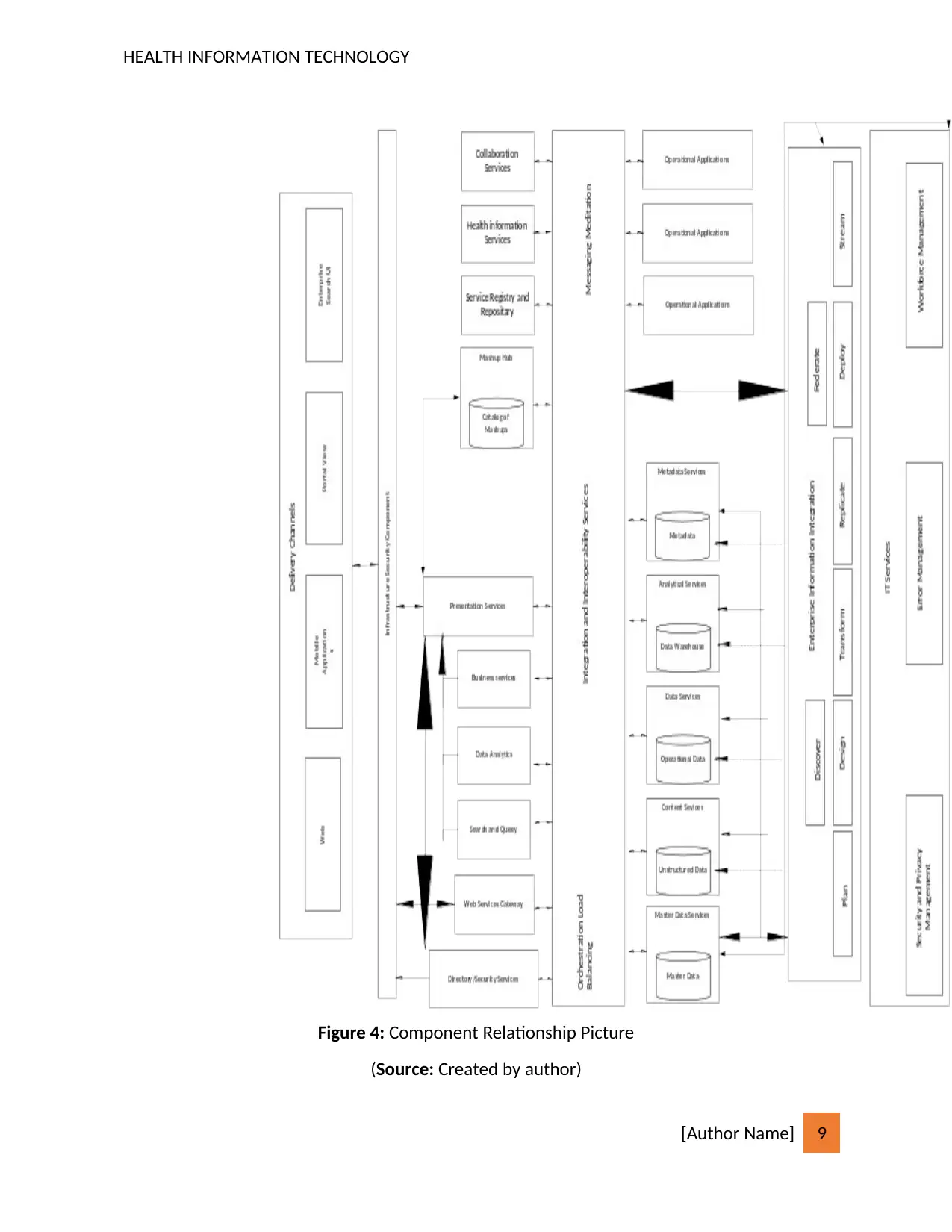
HEALTH INFORMATION TECHNOLOGY
Figure 4: Component Relationship Picture
(Source: Created by author)
[Author Name] 9
Figure 4: Component Relationship Picture
(Source: Created by author)
[Author Name] 9
⊘ This is a preview!⊘
Do you want full access?
Subscribe today to unlock all pages.

Trusted by 1+ million students worldwide
1 out of 20
Related Documents
Your All-in-One AI-Powered Toolkit for Academic Success.
+13062052269
info@desklib.com
Available 24*7 on WhatsApp / Email
![[object Object]](/_next/static/media/star-bottom.7253800d.svg)
Unlock your academic potential
Copyright © 2020–2025 A2Z Services. All Rights Reserved. Developed and managed by ZUCOL.





